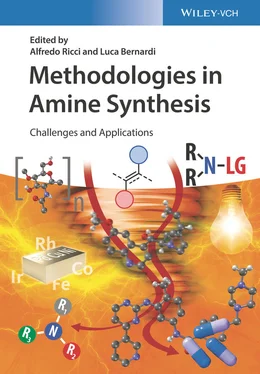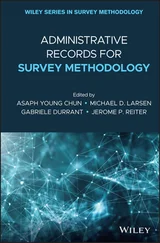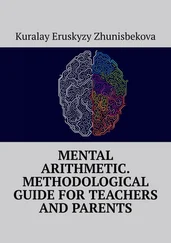2.5 Summary and Conclusions
Nitrogen radicals are powerful intermediates in synthetic chemistry. Their ability to undergo selective H‐atom transfer reactions represents a valuable tool for the assembly and functionalization of organic molecules. Although the large body of work and examples are already available, several challenges are still unsolved. For example, the ability to control in a general sense the stereochemical outcome of these transformations is currently not possible but would be highly desirable. Furthermore, these processes have rarely been used in large‐scale settings, especially at an industrial level, so further work would be required to identify reaction protocols that can be translated into process development. Finally, an area where continuous development and application is required involves the use of these strategies for the late‐stage modification of complex and bioactive materials. The ability to selectively target specific and unactivated sp 3‐centers, where a functionality can be introduced, would represent a powerful tool in order to better explore chemical space around lead molecules.
1 1 Ricci, A. (2008). Amino Group Chemistry. Weinheim, Germany: Wiley‐VCH.
2 2 Zard, S.Z. (2008). Chemical Society Reviews 37: 1603–1618.
3 3 Stateman, L.M., Nakafuku, K.M., and Nagib, D.A. (2018). Synthesis 50: 1569.
4 4 Chen, J.‐R., Hu, X.‐Q., Lu, L.Q., and Xiao, W.‐J. (2016). Chemical Society Reviews: 2044–2056.
5 5 Stella, L. (1983). Angewandte Chemie, International Edition 22: 337.
6 6 Wolff, M.E. (1963). Chemical Reviews 63: 55.
7 7 Hofmann, A.W. (1879). Berichte der Deutschen Chemischen Gesellschaft 12: 984–990.
8 8 Nechab, M., Mondal, S., and Bertrand, M.P. (2014). Chemistry ‐ A European Journal 20: 16034.
9 9 Katohgi, M., Togo, H., Yamaguchi, K., and Yokoyama, M. (1999). Tetrahedron 55: 14885–14900.
10 10 Luo, Y.‐R. (2003). Handbook of Bond Dissociation Energies in Organic Compounds. CRC Press.
11 11 Walton, J.C. (2014). Accounts of Chemical Research 47: 1406.
12 12 Lessard, J., Griller, D., and Ingold, K.U. (1980). Journal of the American Chemical Society 102: 3262.
13 13 Chow, Y.L., Danen, W.C., Nelsen, S.F., and Rosenblatt, D.H. (1978). Chemical Reviews 78: 243.
14 14 Angelini, L., Davies, J., Simonetti, M. et al. (2019). Angewandte Chemie, International Edition 58: 5003.
15 15 Bietti, M. (2018). Angewandte Chemie, International Edition 57: 16618–16637.
16 16 Hioe, J., Šakić, D., Vrček, V., and Zipse, H. (2015). Organic & Biomolecular Chemistry 13: 157.
17 17 Forrester, A.R., Fullerton, J.D., and McConnachie, G. (1983). Journal of the Chemical Society, Perkin Transactions 1: 1759.
18 18 Forrester, A.R., Napier, R.J., and Thomson, R.H. (1981). Journal of the Chemical Society, Perkin Transactions 1: 984.
19 19 Forrester, A.R., Gill, M., Sadd, J.S., and Thomson, R.H. (1979). Journal of the Chemical Society, Perkin Transactions 1: 612.
20 20 Forrester, A.R., Gill, M., Sadd, J.S., and Thomson, R.H. (1975). Journal of the Chemical Society, Chemical Communications: 291.
21 21 Narasaka, K. and Kitamura, M. (2005). European Journal of Organic Chemistry: 4505.
22 22 Davies, J., Booth, S.G., Essafi, S. et al. (2015). Angewandte Chemie, International Edition 54: 14017.
23 23 Davies, J., Svejstrup, T.D., Reina, D.F. et al. (2016). Journal of the American Chemical Society 138: 8092.
24 24 Davies, J., Morcillo, S.P., Douglas, J.J., and Leonori, D. (2018). Chemistry ‐ A European Journal 24: 12154.
25 25 Li, J., Zhang, P., Jiang, M. et al. (2017). Organic Letters 19: 1994.
26 26 Li, Y., Mao, R., and Wu, J. (2017). Organic Letters 19: 4472.
27 27 Shu, W. and Nevado, C. (2017). Angewandte Chemie, International Edition 56: 1881.
28 28 Jiang, H., An, X., Tong, K. et al. (2015). Angewandte Chemie, International Edition 54: 4055.
29 29 Shen, X., Zhao, J.‐J., and Yu, S. (2018). Organic Letters 20: 5523.
30 30 Chen, L., Guo, L.‐N., Ma, Z.‐Y. et al. (2019). The Journal of Organic Chemistry 84: 6475–6482.
31 31 Wu, K., Wang, L., Colón‐Rodríguez, S. et al. (2019). Angewandte Chemie, International Edition 58: 1774–1778.
32 32 Cismenia, M.A. and Yoon, T.P. (2015). Chemical Science 6: 5426.
33 33 Duncton, M.A.J. (2011). Medicinal Chemistry Communications 2: 1135.
34 34 Chen, H., Fan, W., Yuan, X.‐A., and Yu, S. (2019). Nature Communications 10: 4743.
35 35 Quin, Q. and Yu, S. (2015). Organic Letters 17: 1894.
36 36 Jiang, H. and Studer, A. (2018). Angewandte Chemie, International Edition 57: 1692.
37 37 Morcillo, S.P., Dauncey, E.M., Kim, J.H. et al. (2018). Angewandte Chemie, International Edition 57: 12945.
38 38 Davies, J., Sheikh, N.S., and Leonori, D. (2017). Angewandte Chemie, International Edition 56: 13361.
39 39 Miller, D.C., Choi, G.J., Orbe, H.S., and Knowles, R.R. (2015). Journal of the American Chemical Society 137: 13492.
40 40 Choi, G.J., Zhu, Q., Miller, D.C. et al. (2016). Nature 539: 268–271.
41 41 Chu, J.C.K. and Rovis, T. (2016). Nature 539: 272–275.
42 42 Xu, B. and Tambar, U.K. (2019). ACS Catalysis 9: 4627–4631.
43 43 Thullen, S.M., Treacy, M.S., and Rovis, T. (2019). Journal of the American Chemical Society 141: 14062–14067.
44 44 Zhang, H. and Muniz, K. (2017). ACS Catalysis 7: 4122.
45 45 Becker, P., Duhamel, T., Stein, C.J. et al. (2017). Angewandte Chemie, International Edition 56: 8004.
46 46 Martinez, C. and Muniz, K. (2015). Angewandte Chemie, International Edition 54: 8287.
47 47 Bergès, J., García, B., and Muñiz, K. (2018). Angewandte Chemie, International Edition 57: 15891–15895.
48 48 Wappes, E.A., Nakafuku, K.M., and Nagib, D.A. (2017). Journal of the American Chemical Society 139: 10204.
49 49 Nakafuku, K.M., Twumasi, R.K., Vanitcha, A. et al. (2019). The Journal of Organic Chemistry 84: 13065–13072.
50 50 Gomez‐Suarez, A., Gasperini, D., Vummaleti, S.V.C. et al. (2014). ACS Catalysis 4: 2701.
51 51 Hernandez, R., Rivera, A., Salazar, J.A., and Suarez, E. (1980). Journal of the Chemical Society, Chemical Communications: 958.
52 52 Francisco, C.G., Herrera, A.J., and Suarez, E. (2003). The Journal of Organic Chemistry 68: 1012.
53 53 Francisco, C.G., Herrera, A.J., Martin, A. et al. (2007). Tetrahedron 48: 6384.
54 54 Martin, A., Perez‐Mertin, I., and Suarez, E. (2009). Tetrahedron 65: 6147.
55 55 Tang, N., Wu, X., and Zhu, C. (2019). Chem. Sci. 10: 6915–6919.
56 56 Na, C.G. and Alexanian, E.J. (2018). Angewandte Chemie, International Edition 57: 13106–13109.
57 57 Short, M.A., Blackburn, J.M., and Roizen, J.L. (2017). Angewandte Chemie, International Edition 57: 296.
58 58 Ayer, S.K. and Roizen, J.L. (2019). The Journal of Organic Chemistry 84: 3508–3523.
59 59 Torres‐Ochoa, R.O., Leclair, A., Wang, Q., and Zhu, J. (2019). Chemistry ‐ A European Journal 25: 9477–9484.
60 60 Groendyke, B.J., AbuSalim, D.I., and Cook, S.P. (2016). Journal of the American Chemical Society 138: 12771.
61 61 Li, Z., Wang, Q., and Zhu, J. (2018). Angewandte Chemie, International Edition 57: 13288.
62 62 Zhang, Z., Zhang, X., and Nagib, D.A. (2019). Chem 5: 3127.
3 Radical‐Based C—N Bond Formation in Photo/Electrochemistry
Binbin Huang1, Yating Zhao2, and Wujiong Xia1
1Harbin Institute of Technology, State Key Lab of Urban Water Resource and Environment, School of Science, Shenzhen, 518055, China
2Quzhou University, College of Chemical and Material Engineering, Quzhou, China, 324000
As ubiquitous fundamental linkages, C—N bonds prevalently exist in various value‐added compounds such as natural products, pharmaceutical agents, functional materials, synthetic intermediates, and coordinating ligands. Thus, developing efficient methodologies for the construction of C—N bonds has always been a hot research goal in synthetic chemistry [1]. Among the existing approaches toward C—N bonds, cross‐dehydrohalogenative couplings of C—H/N—X (X = halide or pseudo ‐halide) bonds or C—X/N—H bonds are generally well established, highly efficient, and consequently widely used, including the classical Buchwald–Hartwig amination and Ullman amination. However, from the perspective of green chemistry, these methods are not the ideal choices because the requirement for prefunctionalization of the coupling substrates considerably lowers their atom and step economy.
Читать дальше









